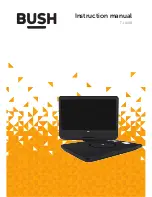
to the customer.
3. PREVENTION OF ELECTRO STATIC DISCHARGE
(ESD) TO ELECTROSTATICALLY SENSITIVE (ES)
DEVICES
Some semiconductor (solid state) devices can be damaged easily by static electricity. Such
components commonly are called Electrostatically Sensitive (ES) Devices. Examples of typical
ES devices are integrated circuits and some field-effect transistorsand semiconductor "chip"
components. The following techniques should be used to help reduce the incidence of
component damage caused by electro static discharge (ESD).
1. Immediately before handling any semiconductor component or
semiconductor-equipped assembly, drain off any ESD on your
body by touching a known earth ground. Alternatively, obtain and
wear a commercially available dischargingESD wrist strap, which
should be removed for potential shock reasons prior to applying
power to the unit under test.
2. After removing an electrical assembly equipped with ES devices,
place the assembly on a conductive surface such as alminum foil,
to prevent electrostatic charge buildup or exposure of the
assembly.
3. Use only a grounded-tip soldering iron to solder or unsolder ES
devices.
4. Use only an anti-static solder removal device. Some solder
removal devices not classified as "anti-static (ESD protected)"
can generate electrical charge sufficient to damage ES devices.
5. Do not use freon-propelled chemicals. These can generate
electrical charges sufficient to damage ES devices.
6. Do not remove a replacement ES device from its protective
package until immediately before you are ready to install it. (Most
replacement ES devices are packaged with leads electrically
shorted together by conductive foam, alminum foil or
comparableconductive material).
7. Immediately before removing the protective material from the
leads of a replacement ES device, touch the protective material to
the chassis or circuit assembly into which the device will be
Summary of Contents for DVD-S75EG
Page 2: ......
Page 13: ...8 5 Front Panel 1 Release the tabs 2 Remove the connector ...
Page 19: ...9 2 Traverse Unit 1 Remove the connector ...
Page 29: ...2 Remove the pins 3 Remove the traverse deck ...
Page 43: ......
Page 59: ...19 2 Mechanism Section Exploded View ...
Page 60: ...19 3 Packing Accessories Section Exploded View ...
Page 76: ......
Page 77: ......
Page 78: ......
Page 79: ......
Page 80: ......
Page 81: ...Ref No MODE 1 2 3 PLAY 3 2 0 3 3 STOP 3 2 0 3 3 IC6101 ...
Page 82: ......
Page 83: ......
Page 84: ......
Page 85: ......
Page 86: ......
Page 89: ......
Page 94: ...ï ß Þ Ý Ü Û Ú î í ì ë ê é ...
Page 96: ......
Page 97: ......
Page 98: ......
Page 99: ...ÐÑÉÛÎ ÍËÐÐÔÇ ÐòÝòÞò ...
Page 100: ......
Page 102: ......
Page 103: ......
Page 105: ......
Page 106: ......
Page 107: ......
Page 108: ......
Page 111: ...ïé ÍÝØÛÓßÌ Ý Ü ßÙÎßÓ ïéòïò ÐÑÉÛÎ ÍËÐÐÔÇ ÍÝØÛÓßÌ Ý Ü ßÙÎßÓ ìé ...
Page 112: ...ÜÊÜóÍéëÛÙñÛÞñÛ ÐÑÉÛÎ ÍËÐÐÔÇ ÍÝØÛÓßÌ Ý Ü ßÙÎßÓ ìé ...
Page 113: ...ïéòîò ÒÌÛÎÓÛÜ ßÌÛ ÍÝØÛÓßÌ Ý Ü ßÙÎßÓ ìè ...
Page 114: ...ÜÊÜóÍéëÛÙñÛÞñÛ ÒÌÛÎÓÛÜ ßÌÛ ÍÝØÛÓßÌ Ý Ü ßÙÎßÓ ìè ...
Page 115: ...ïéòíò ÚÑÎÛ ÍÛÝÌ ÑÒ øÓÑÜËÔÛ ÐòÝòÞò øïñí ÍÝØÛÓßÌ Ý Ü ßÙÎßÓ ìç ...
Page 117: ...ïéòìò ÜÊï ÍÛÝÌ ÑÒ øÓÑÜËÔÛ ÐòÝòÞò øîñí ÍÝØÛÓßÌ Ý Ü ßÙÎßÓ ëð ...
Page 119: ...ïéòëò Ø ÒÜ ÍÛÝÌ ÑÒ øÓÑÜËÔÛ ÐòÝòÞò øíñí ÍÝØÛÓßÌ Ý Ü ßÙÎßÓ ëï ...
Page 121: ...ïéòêò Ê ÜÛÑ ÑËÌ ÍÛÝÌ ÑÒ øÓÑÌØÛÎ ÐòÝòÞò øïñì ÍÝØÛÓßÌ Ý Ü ßÙÎßÓ ëî ...
Page 123: ...ïéòéò ßËÜ Ñ ÑËÌï ÍÛÝÌ ÑÒ øÓÑÌØÛÎ ÐòÝòÞò øîñì ÍÝØÛÓßÌ Ý Ü ßÙÎßÓ ëí ...
Page 125: ...ïéòèò ßËÜ Ñ ÑËÌî ÍÛÝÌ ÑÒ øÓÑÌØÛÎ ÐòÝòÞò øíñì ÍÝØÛÓßÌ Ý Ü ßÙÎßÓ ëì ...
Page 129: ...ïéòïðò ÍÝßÎÌ ÍÝØÛÓßÌ Ý Ü ßÙÎßÓ ëê ...
Page 130: ...ÜÊÜóÍéëÛÙñÛÞñÛ ÍÝßÎÌ ÍÝØÛÓßÌ Ý Ü ßÙÎßÓ ëê ...
Page 131: ...ïéòïïò ÚÎÑÒÌ øÔ ñ ÚÎÑÒÌ øÎ ÍÝØÛÓßÌ Ý Ü ßÙÎßÓ ëé ...
Page 132: ...ÜÊÜóÍéëÛÙñÛÞñÛ ÚÎÑÒÌøÔ ñÚÎÑÒÌøÎ ÍÝØÛÓßÌ Ý Ü ßÙÎßÓ ëé ...









































